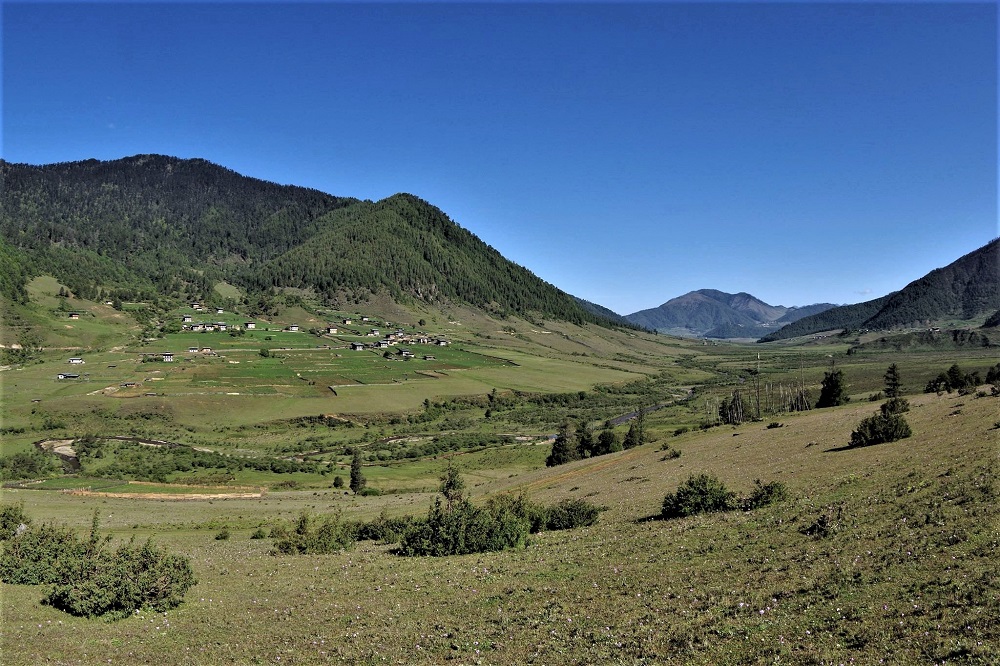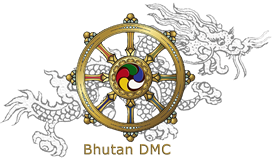Gangtey (altitude 3,000m) - A beautiful glacial valley and the winter home to endangered black necked cranes that arrive every year from the Tibetan Plateau

The valley of Gangtey is one of the most beautiful spots in Bhutan. The surprise of finding such a wide, flat valley without any trees after the hard climb through dense forests is augmented by an impression of vast space, and extremely rareexperience in Bhutan where most of the valley’s are tightly enclosed.
At 3000 metres, Phobjikha is one of Bhutan’s few glacial valleys and a unique conservation area in the Black Mountians National Park. According to legend, its two streams called Black and White waters – one languid, the other vivacious, symbolize a snake and a boar who once raced through the valley. The snake lost and to this day, the rice he wished for cannot grow in Phobjikha. Only a scattering of hamlets betrays the human presence on the edge of vast wetlands, the winter grounds of black-necked cranes.
Gangtey Goempa
Perched on a small hill that rises from the valley floor, the Gangtey Monastery is the only Nyingmapa monastery on the western side of the Black Mountain’s and also the biggest Nyingmapa monastery in Bhutan. The Monastery is surrounded by a large village inhabited mainly by the families of the 140 Gomchens who take care of the Monastery.
Gangtey was founded by Pema Trinley, the grand son of Pema Lingpa, the famous Nyingmapa saint of Bhutan. In 1613, Pema Trinley establish the monastery and became the first Gangtey Tulku. The religious traditions of Pema Lingpa still taught there. The second Tulku, Tenzin Legpa Dondrup (1645 to 1726), enhanced the size of Gangtey while keeping up good relations with Drukpas, and rebuilt the monastery in the form of a Dzong.
Phobjikha Valley
It is a wide glacial valley with a central stream meandering through the open grassland and thickets of dwarf bamboo. Farmlands occupy the peripheral slopes where potatoes and turnips are grown. The forests beyond the farms are mostly coniferous. The general vegetation is composed of mainly blue pine (Pinus wallichiana), birch (Betula utilis), maple (Acer spp.) and several species of rhododendrons. The Central Valley inhabited by the cranes in winter has mostly dwarf bamboo. The repeated grazing of the bamboos by the local cattle and horses in summer prepares the ground for the wintering Cranes. The magnificent, Black-necked Cranes heighten the breath-taking scenery of Phobjikha in winter respiratory.
Black-necked Crane Visitor Centre (BNCVC)
The BNCVC serves as a resource and information center on sustainable eco-tourism activities, environment education and conservation programs in Phobjikha valley. The center is housed in a single storey building overlooking the picturesque wetlands which is the Black-necked Crane habitat. This vantage location of the center allows visitors to relax and spot Black-necked Cranes and other bird species in the valley. The center’s observatory is equipped with bird watching telescopes and binoculars.
The Centre has a display room where interpretative panels and information on the black-necked cranes, flora and fauna, community life and culture of the valley, etc. are displayed. Adjacent to the display room is a mini-theatre hall that doubles as a conference room. The mini-theatre is used for screening of documentaries, films and presentations on Black-necked Cranes both for orientation and educational purposes. The Centre also houses a small souvenir shop.
HOTELS IN THIMPHU
HOTELS IN PUNAKHA & WANGDUE
HOTELS IN GANGTEY
HOTELS IN TRONGSA
HOTELS IN BUMTHANG
HOTELS IN MONGAR
HOTELS IN TRASHIGANG
HOTELS IN SAMDRUP JONGKHAR
HOTELS IN PHUENTSHOLING
HOTELS IN HAA
HOTELS IN GELEPHU
HOTELS IN ZHEMGANG
RESTAURANTS IN PARO
RESTAURANTS IN THIMPHU
RESTAURANTS IN PUNAKHA
TOUR ITINERARIES
TREKKING ITINERARIES
SPECIAL INTERESTS TOURS
UNIQUE FESTIVALS & FAIRS
BLOG


